Content for TR 23.700-12 Word version: 17.1.0
6 Solutions
6.1 Solution #1: Conveying UPF FQDN to IMS nodes
6.2 Solution #2: IMS utilize services provided by AMF
6.3 Solution #3: P-CSCF directly communicates UDM
6.4 Solution #4: Conveying UPF service area to IMS nodes via PCF N5
6.5 Solution #5: Discovery of NFs from IMS nodes
6.6 Solution #6: P-CSCF discovery support with one slice connecting to multiple IMS network
6.7 Solution #7: IMS node communicating directly to UDM to fetch UPF information
6 Solutions p. 8
6.1 Solution #1: Conveying UPF FQDN to IMS nodes p. 8
6.1.1 Description p. 8
This is a solution to key issue #1.
This solution proposes to convey the UPF FQDN or a more generic information like "user-plane-locality" or "voice-media-locality" for the IMS PDU session from SMF to UDM during SMF registration. The UDM stores the IMS PDU session's UPF FQDN (or "user-plane-locality" or "voice-media-locality") in the UDR as part of the SMF registration. The HSS retrieves the IMS PDU session's UPF FQDN (or "user-plane-locality" or voice-media-locality") from the UDR and forwards it to the S-CSCF via Cx (or Nhss-ims) when an S-CSCF registers. When performing call setup procedure, the S-CSCF on the MO side convey the UPF FQDN (or "user-plane-locality" or voice-media-locality") of the MO UE to the BGCF via SIP messages.
When the BGCF determines that selection of an MGCF close to the actual UPF is required, it makes use of the conveyed UPF FQDN (or "user-plane-locality" or "voice-media-locality") and maps it based on a locally configured mapping table or using discovery via NRF (see solution#5) to the optimal MGCF.
When the IMS-AS determines that selection of an MGCF or MRF close to the actual UPF is required, it retrieves the UPF FQDN (or "user-plane-locality" or "voice-media-locality") via HSS from the UDR and selects (based on a locally configured mapping table or using discovery via NRF (see solution#5)) the optimal MRF for the actual UPF.
6.1.2 Impacts on existing nodes and functions p. 8
6.1.2.1 SMF p. 8
When the SMF makes use of the Nudm_UECM_registration service operation to register for the IMS PDU session at the UDM, it needs to convey the actual UPF FQDN (or "user-plane-locality" or "voice-media-locality") to the UDM.
6.1.2.2 UDM p. 8
When the UDM receives the actual UPF FQDN (or "user-plane-locality" or voice-media-locality") within the Nudm_UECM_registration service operation, it needs to store the UPF FQDN (or "user-plane-locality" or voice-media-locality") as part of the SmfRegistration in the UDR.
6.1.2.3 UDR p. 8
When the UDM makes use of the Nudr_DR_Create service operation to store the SMF registration for the IMS PDU session, it needs to store the received UPF FQDN (or "user-plane-locality" or "voice-media-locality").
When the HSS makes use of the Nudr_DR_Query service operation to retrieve SMF registration for the IMS PDU session, the UDR needs to respond with the SmfRegistration including the stored UPF FQDN (or "user-plane-locality" or "voice-media-locality").
6.1.2.4 HSS p. 8
When the HSS receives a registration request from the S-CSCF or a request from the IMS-AS to provide the UPF FQDN (or "user-plane-locality" or "voice-media-locality"), in needs to make use of the Nudr_DR_Query service operation to retrieve the UPF FQDN (or "user-plane-locality" or "voice-media-locality") from the UDR as part of the SmfRegistration for the IMS PDU session, and return the retrieved UPF FQDN (or "user-plane-locality" or "voice-media-locality") to the IMS-AS or S-CSCF.
6.1.2.5 S-CSCF p. 8
The S-CSCF on the MO side forwards the received UPF FQDN (or "user-plane-locality" or "voice-media-locality") to the BGCF.
6.1.2.6 BGCF p. 9
When the BGCF determines that an MGCF close to the actual UPF need to be selected, it makes use of the UPF FQDN (or "user-plane-locality" or "voice-media-locality") received from the S-CSCF and maps it according to a locally configured mapping table to an optimal MGCF.
6.1.2.7 IMS-AS p. 9
When the IMS-AS determine that an MRF close to the actual UPF need to be selected, it needs to retrieve the actual UPF FQDN (or "user-plane-locality" or "voice-media-locality") for the IMS PDU session from the HSS. The IMS-AS then makes use of the UPF FQDN (or "user-plane-locality" or "voice-media-locality") and maps it according to a locally configured mapping table to an optimal MRF.
6.2 Solution #2: IMS utilize services provided by AMF p. 9
6.2.1 Description p. 9
This solution addresses Key Issue #2: How can IMS utilize services provided by 5GC NFs other than PCF.
In IMS network, the P-CSCF needs to be notified of some events related to access network, e.g. UE location information and other access network related events. This information will be used in IMS network for billing, LI, service trigger and so on. In 4G, the P-CSCF subscribes to notification of these events over Rx interface. Since 5GC supports SBI, IMS network is able to use the SBI provided by AMF to subscribe to notification of these events.
Figure 6.2.1-1 illustrates how IMS obtains the AMF address serving the UE during IMS registration procedure.
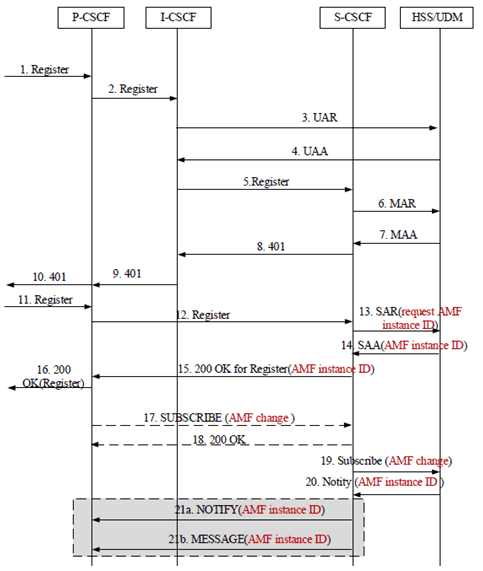
Figure 6.2.1-1: IMS obtains the AMF instance ID during IMS registration procedure
(⇒ copy of original 3GPP image)
(⇒ copy of original 3GPP image)
Step 1-12.
Once the IMS (P-CSCF) obtains the instance ID of the AMF serving the UE, the IMS (P-CSCF) can subscribe to notification of the events supported by AMF e.g. events related to UE location information and access network information. Before the IMS (P-CSCF) invoking services provided by AMF, it needs to query NRF with the received AMF instance ID to get the AMF endpoints to which it can invoke service request.
Figure 6.2.1-2 illustrates the P-CSCF utilizes services provides by AMF to subscribe to notification of the UE location information.
Normal IMS registration procedure.
Step 13.
The S-CSCF requests the AMF instance ID in SAR from the HSS/UDM.
Step 14.
The HSS/UDM sends AMF instance ID in the SAA to the S-CSCF.
Step 15.
The S-CSCF sends the AMF instance ID to the P-CSCF in the SIP 200 OK.
Step 16.
The P-CSCF sends SIP 200 OK to the UE as in normal IMS registration procedure.
Step 17.
(Option A) The P-CSCF subscribes to AMF change event from S-CSCF.
Step 18.
(Option A) The S-CSCF responds to P-CSCF.
Step 19.
The S-CSCF subscribes to notification of AMF change to the HSS/UDM.
Step 20.
When the AMF changes, the HSS/UDM notifies the S-CSCF.
Step 21a.
(Option A) The S-CSCF sends SIP NOTIFY with the new AMF instance ID to the P-CSCF.
Step 21b.
(Option B) The S-CSCF sends SIP MESSAGE with the new AMF instance ID to the P-CSCF.
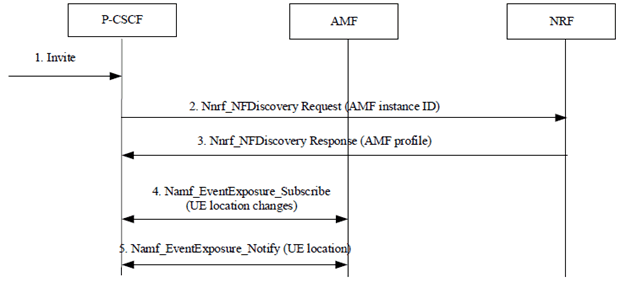
Figure 6.2.1-2: P-CSCF utilizes Services provided by AMF to subscribe to notification of the UE location information
(⇒ copy of original 3GPP image)
(⇒ copy of original 3GPP image)
Step 1.
When the UE moves from the old AMF to the new AMF, the S-CSCF receives notification from the UDM/HSS, and the S-CSCF notifies the P-CSCF of the new AMF address. The P-CSCF invokes Namf_
The P-CSCF receives the SIP INVITE message.
Step 2.
The P-CSCF queries NRF with previously received AMF instance ID, to get the AMF profile.
Step 3.
The NRF responds to P-CSCF with the AMF profile.
Step 4.
The P-CSCF invokes Namf_EventExposure_Subscribe service operation, based on the AMF profile received in step 3, for event subscription to UE location changes.
Step 5.
When the UE location changes, the AMF invokes Namf_EventExposure_Notify to notify the P-CSCF of the UE location.
6.2.2 Impacts on existing nodes and functions p. 11
6.2.2.1 HSS p. 11
Nhss services specified in TS 29.562 needs to be enhanced to:
- Retrieve AMF instance ID; and
- subscribe and notify AMF instance ID change event.
6.2.2.2 CSCF p. 12
P-CSCF needs to:
- subscribe AMF instance ID change event from S-CSCF; and
- utilize services provides by AMF to subscribe to notification of UE location information.
- Retrieve AMF instance ID from HSS; and
- subscribe and notify AMF instance ID change event from HSS.
6.2.3 Solution Evaluation p. 12
The solution enables IMS network to use the SBI provided by AMF to subscribe to notification of events related to access network, e.g. UE location information and other access network related events. In Figure 6.2.1-1, Option A is better than Option B as Option A provides more flexibility.
6.3 Solution #3: P-CSCF directly communicates UDM p. 12
6.3.1 Description p. 12
This solution addresses Key Issue #2: How can IMS utilize services provided by 5GC NFs other than PCF. This solution differs from solution #2 mainly on how the P-CSCF gets the serving AMF of the UE.
This solution proposes P-CSCF directly communicates with UDM to get the necessary information, the procedure is shown in Figure 6.3.1-1.
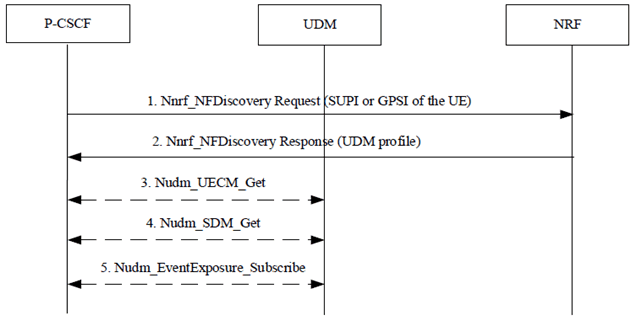
Step 1.
The P-CSCF invoke Nnrf_NFDiscovery service towards a preconfigured NRF to get the UDM which can serve the UE, in the service request the P-CSCF include the SUPI or GPSI of the UE as query. The P-CSCF derives the SUPI or GPSI from the IMPI or IMPU of the UE.
Step 2.
The NRF responds to P-CSCF with the profile of the UDM which can serve the UE.
Step 3.
The P-CSCF may invoke Nudm_UECM service towards the UDM to get the context information of the UE.
Step 4.
The P-CSCF may invoke Nudm_SDM service towards the UDM to get the subscription information of the UE.
Step 5.
The P-CSCF may invoke Nudm_EventExposure service towards the UDM to subscribe events of interest.
6.3.2 Impacts on existing nodes and functions p. 13
6.3.2.1 P-CSCF p. 13
P-CSCF shall be able to invoke services provided by NRF and UDM.
6.3.3 Solution Evaluation p. 13
See clause 7.2.
6.4 Solution #4: Conveying UPF service area to IMS nodes via PCF N5 p. 13
6.4.1 Description p. 13
This is a solution to key issue #1.
This solution proposes to convey the UPF service area for the IMS PDU session from SMF to PCF and on to P-CSCF during multimedia session establishment. The PCF either stores the UPF service area as part of the SM policy or fetches the UPF service area from the SMF when requested by P-CSCF. PCF may also subscribe to a new event "UPF service area change" upon establishment of the SM policy association.
When the P-CSCF receives a multimedia session request, it fetches the UPF service area (and possibly network provided location information, see Annex B.8 in TS 29.514) and selects (based on a locally configured mapping from UPF service area) the optimal MGW (e.g. ATGW) for the actual UPF service area.
The P-CSCF forwards the UPF service area retrieved from PCF in the SIP request (e.g. as part of the PANI header). Other IMS functions (e.g. MGCF, IMS-AS) may use the information to select, e.g. optimal IM-MGW, MRF.
Figure 6.4.1-1 illustrates how IMS obtains the UPF service area at multimedia session establishment.
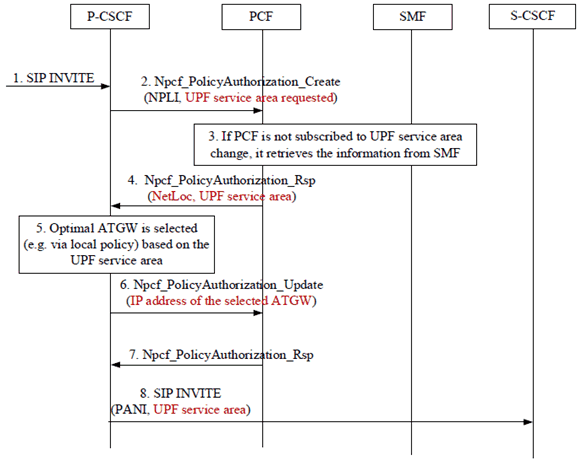
Step 1.
P-CSCF receives an initial session request.
Step 2.
Based on local policy, P-CSCF requests the current UPF service area (possibly with NPLI) via Npcf_PolicyAuthorization_Create .
Step 3.
Either UPF service area is available at PCF (e.g. SMF included the information based on local policy at Npcf_SMPolicyControl_Create ) or PCF requests the information from SMF (Npcf_SMPolicyControl_UpdateNotify ).
Step 4.
PCF returns the UPF service area (possibly with NPLI, if requested previously).
Step 5.
Based on current UPF service area, P-CSCF selects an optimal MGW/ATGW, using local configuration.
Step 6.
P-CSCF invokes Npcf_PolicyAuthorization_Update service operation to provide the IP address used for the session on the selected MGW/ATGW.
Step 7.
PCF responds to the Npcf_PolicyAuthorization_Update request.
Step 8.
Before forwarding the SIP request, P-CSCF includes the UPF service area (e.g. in SIP PANI header) so that IMS nodes (e.g. IMS-AS) may use it to assist a media plane function (e.g. MRF).
6.4.2 Impacts on existing nodes and functions p. 15
6.4.2.1 SMF p. 15
When the SMF makes use of the Npcf_SMPolicyControl service, it may send (based on local policy) the UPF service area (serving scope) as received from NRF during UPF NF discovery.
6.4.2.2 PCF p. 15
When the PCF receives the Npcf_SMPolicyAuthorization service operation, it may request SMF (based on local policy) to be notified about UPF service area change.
6.4.2.3 P-CSCF p. 15
When the P-CSCF receives the initial SIP request for a multimedia session, it makes use of the Npcf_PolicyAuthorization_Create (based on local policy) to retrieve the UPF service area. The P-CSCF uses the information to select the optimal MGW and include the information in the SIP request before forwarding the request to S-CSCF.
The P-CSCF may also create a new Individual Application Session Context with the PCF for the AF signalling using the Npcf_PolicyAuthorization_Create service operation in order to subscribe to UPF (service area) changes so that, at call establishment, the current UPF information is already known to P-CSCF and PCF interaction is skipped (avoiding latency increase).
6.4.2.4 IMS-AS p. 15
When the IMS-AS selects an MRF, it may make use of the UPF service area received in the SIP request.
6.4.2.5 MGCF p. 15
When the MGCF selects an IM-MGW, it may make use of the UPF service area received in the SIP request.
6.4.2.6 BGCF p. 15
When the BGCF selects an MGCF, it may make use of the UPF service area received in the SIP request.
6.5 Solution #5: Discovery of NFs from IMS nodes p. 15
6.5.1 Description p. 15
This is a solution to key issue #2.
The NRF can be provisioned (e.g. via O&M) with new types of NF profiles (e.g. NF types ATGW, IM-MGW, MRF) so that SBI capable P-CSCFs, IMS-ASs, etc. can discover MGWs, MRFs, etc. Such NF profile(s) may contain information about codecs supported, transcoding support, service area (serving scope), etc. without the need of configuring, e.g. ATGWs per UPF service area and the related information on each and every P-CSCF, IMS-AS, MGCF, etc. instance in the network.
Figure 6.5.1-1 illustrates how IMS nodes discover ATGW, IM-MGW, MRF.
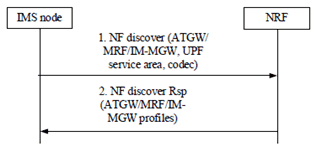
6.5.2 Impacts on existing nodes and functions p. 16
6.5.2.1 IMS-AS p. 16
The IMS-AS discovers and selects an MRF, making use of the UPF service area received in the SIP request.
6.5.2.2 MGCF p. 16
The MGCF discovers and selects an IM-MGW, making use of the UPF service area received in the SIP request.
6.5.2.3 NRF p. 16
New type(s) of NF(s) are defined (e.g. ATGW), with the associated information (e.g. codecs supported, UPF service area) so that they can be discovered by IMS nodes.
6.6 Solution #6: P-CSCF discovery support with one slice connecting to multiple IMS network p. 16
6.6.1 Description p. 16
6.6.1.1 General p. 16
This solution addresses scenario 3 of Key Issue #1 Network Slicing and IMS to support P-CSCF discovery for one slice connecting to different IMS network of TR 23.700-10.
In scenario 3 of KI#1 in TR 23.700-10, different UEs may be connected to their home IMS networks via the same single slice instance, which means the P-CSCF discovery mechanism needs the same SMF to return different P-CSCFs addresses to UEs belonging to different home IMS network.
To fulfil the requirement above, home network domain name of the UE home IMS network is taken into account when the SMF discovers P-CSCF. The SMF can be configured with P-CSCF addresses based on home network domain name granularity, or SMF includes home network domain name when querying NRF for P-CSCF instance. The SMF returns P-CSCF addresses to the UE accordingly.
The home network domain name is retrieved from the UDM. The home network domain name is subscribed and stored as part of Subscriber Data in UDM, which is retrieved by SMF during PDU session establishment procedure by invoking Nudm_SDM_Get service operation.
6.6.1.2 Procedures p. 17
6.6.1.2.1 Procedure with home network domain name retrieved from the UDM p. 17
The following flow describes the procedure for P-CSCF discovery when home network domain name is retrieved from the UDM.
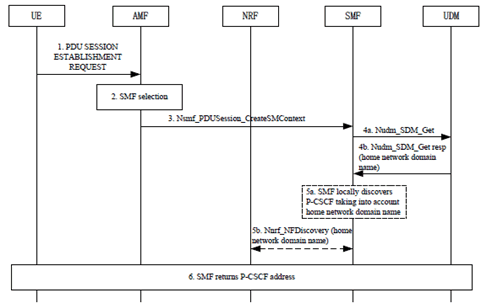
Figure 6.6.1.2.1-1: P-CSCF discovery with home network domain name retrieved from the UDM
(⇒ copy of original 3GPP image)
(⇒ copy of original 3GPP image)
Step 1.
The UE initiates PDU session establishment procedure to create a PDU session for IMS by sending PDU SESSION ESTABLISHMENT REQUEST.
Step 2.
The AMF selects SMF.
Step 3.
The SMF invokes Nsmf_PDUSession_CreateSMContext service operation to create a PDU session for IMS.
Step 4a.
The SMF retrieves session management subscription data from the UDM.
Step 4b.
The home network domain name is provided as part of the subscription data.
Step 5a.
The SMF may discover P-CSCF locally if the SMF is configured with P-CSCF addresses based on home network domain name granularity.
Step 5b.
The SMF may discover P-CSCF via NRF by including home network domain name when invoking Nnrf_NFDiscovery service operation.
Step 6.
The SMF returns the discovered P-CSCF address to the UE following existing procedure.
6.6.2 Impacts on existing nodes and functions p. 17
6.6.3 Solution Evaluation p. 18
6.7 Solution #7: IMS node communicating directly to UDM to fetch UPF information p. 18
6.7.1 Description p. 18
This is a solution to key issue #1.
This solution is a combination of solution#1 and solution#3, as such:
- When the SMF registers to UDM during IMS PDU session, it stores the UPF FQDN or a more generic information like "user-plane-locality" or "voice-media-locality" or "service area" in the UDM. This is as described in clause 6.1.1.
-
When performing call setup procedure, the relevant IMS entity, i.e. IMS node which needs to select an IMS media plane node close to the UPF serving the UE, retrieves the UPF information directly from UDM, the procedure is similar to that described in Figure 6.3.1-1 as such:
- if an MRF close to UPF is to be selected, then the AS communicates with UDM;
- if an MGCF close to UPF is to be selected, then the BGCF communicates with UDM;
- if an IMS-AGW close to UPF is to be selected, then the P-CSCF communicates with UDM;
- if an ATGW close to UPF is to be selected, then the ATCF communicates with UDM;
- if an TrGW close to UPF is to be selected, then the IBCF communicates with UDM.
6.7.2 Impacts on existing nodes and functions p. 18
6.7.2.1 SMF p. 18
When the SMF makes use of the Nudm_UECM_registration service operation to register for the IMS PDU session at the UDM, it needs to convey the actual UPF FQDN (or "user-plane-locality" or "voice-media-locality") to the UDM.
6.7.2.2 UDM p. 18
When the UDM receives the actual UPF FQDN (or "user-plane-locality" or "voice-media-locality" or "service area") within the Nudm_UECM_registration service operation, it needs to store the UPF FQDN (or "user-plane-locality" or "voice-media-locality" or "service area") as part of the SmfRegistration in the UDR.
6.7.2.3 UDR p. 18
When the UDM makes use of the Nudr_DR_Create service operation to store the SMF registration for the IMS PDU session, it needs to store the received UPF FQDN (or "user-plane-locality" or "voice-media-locality" or "service area").
When the HSS makes use of the Nudr_DR_Query service operation to retrieve SMF registration for the IMS PDU session, the UDR needs to respond with the SmfRegistration including the stored UPF FQDN (or "user-plane-locality" or "voice-media-locality" or "service area").
6.7.2.4 IMS control plane nodes p. 18
The IMS control plane nodes, which are required to select a corresponding IMS media plane node close to the UPF serving the UE, need to be enhanced by:
- to support invoking APIs provided by NRF and UDM;
- to make use of the UPF FQDN (or "user-plane-locality" or "voice-media-locality" or "service area") retrieved from the UDM and map it according to a locally configured optimal media plane node.